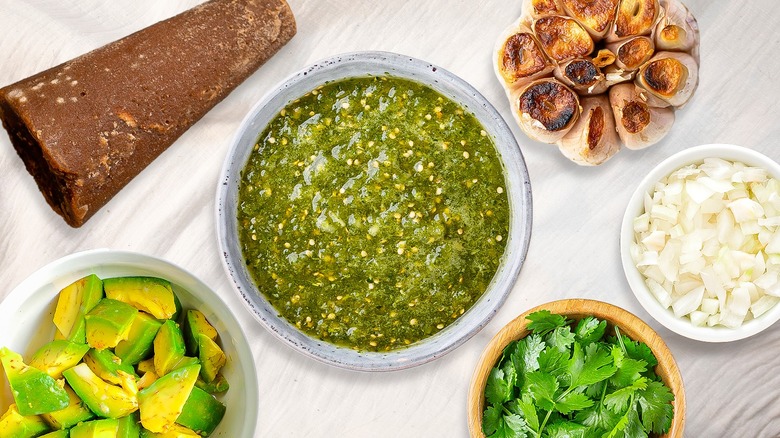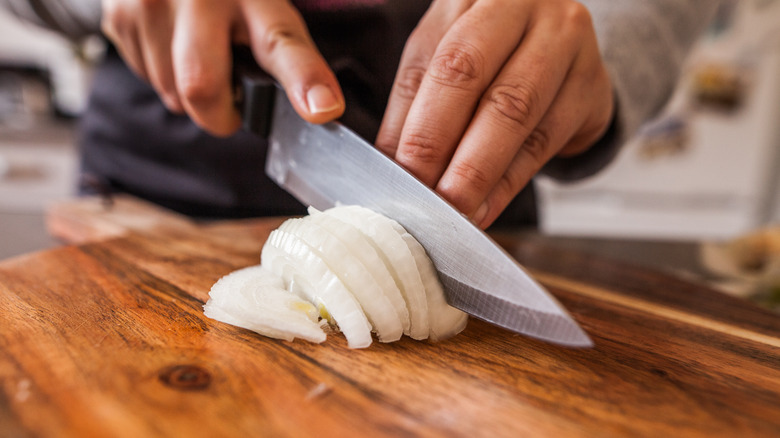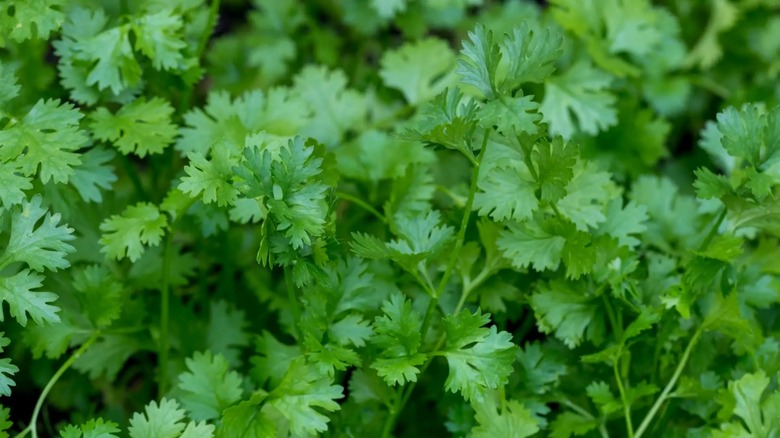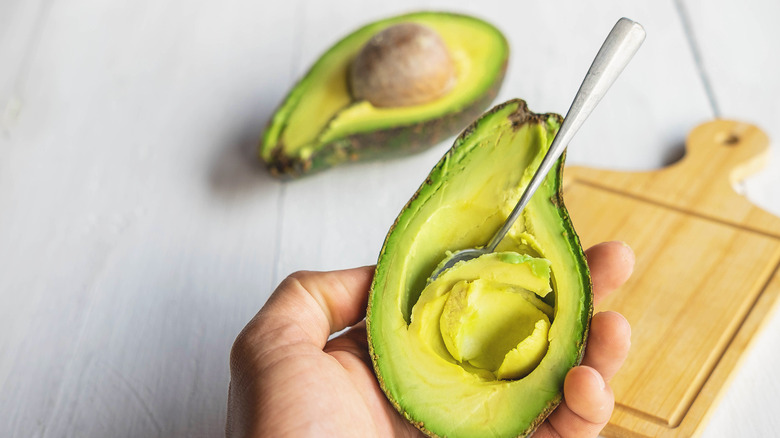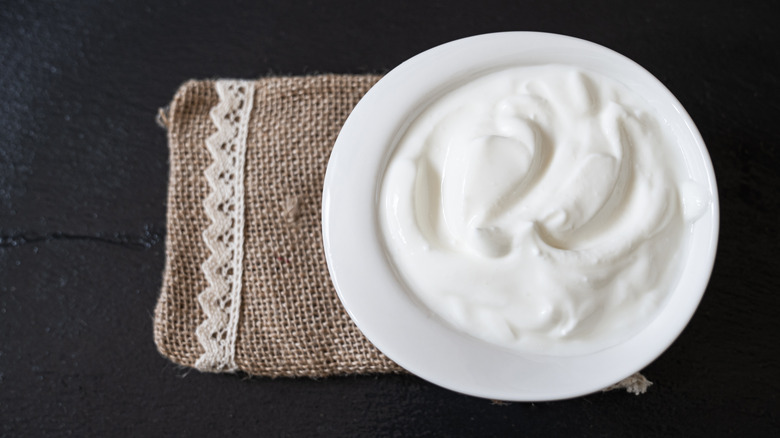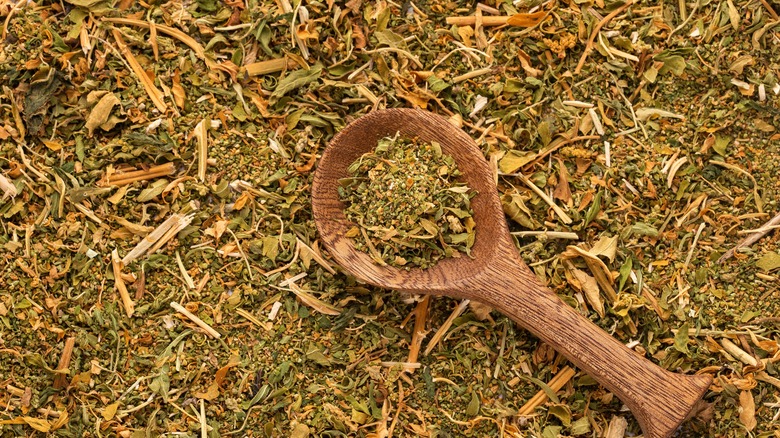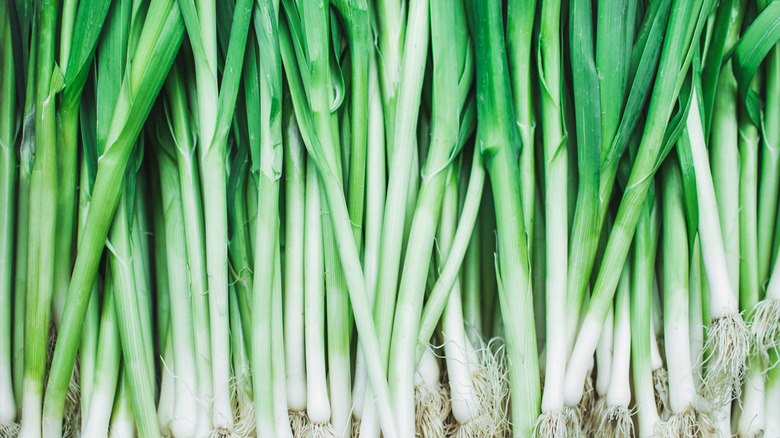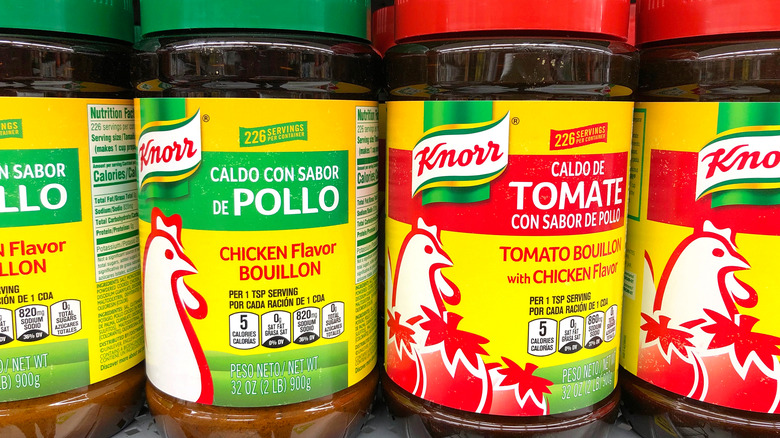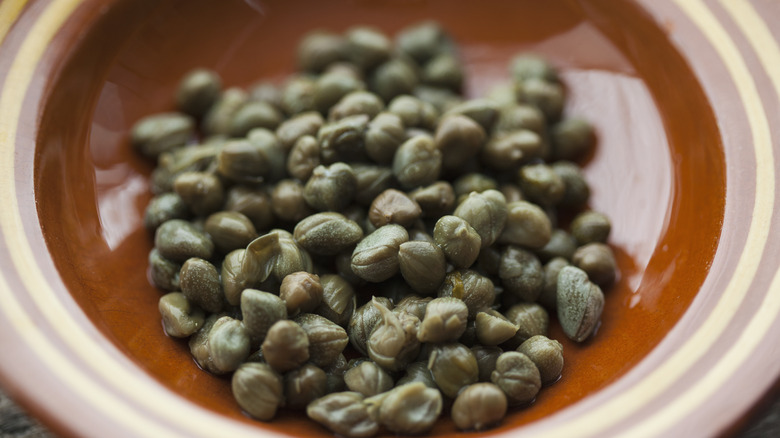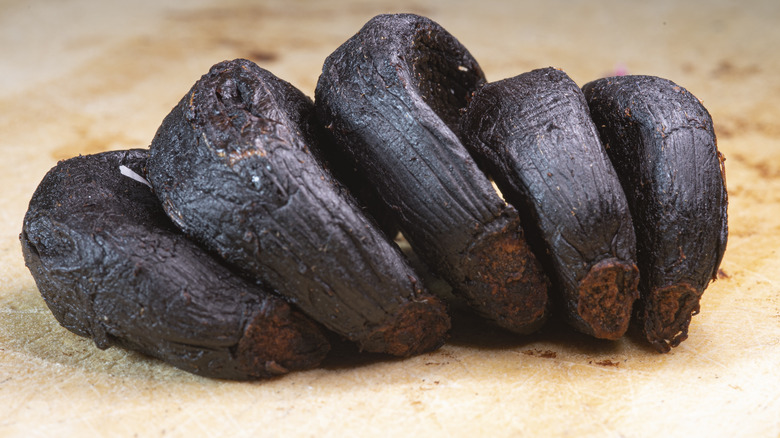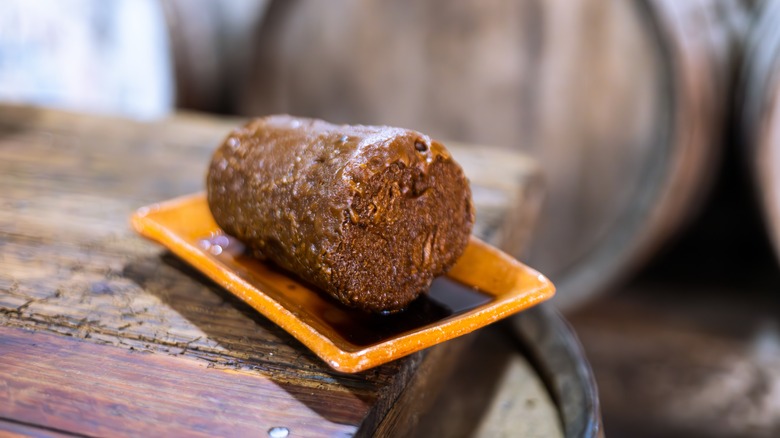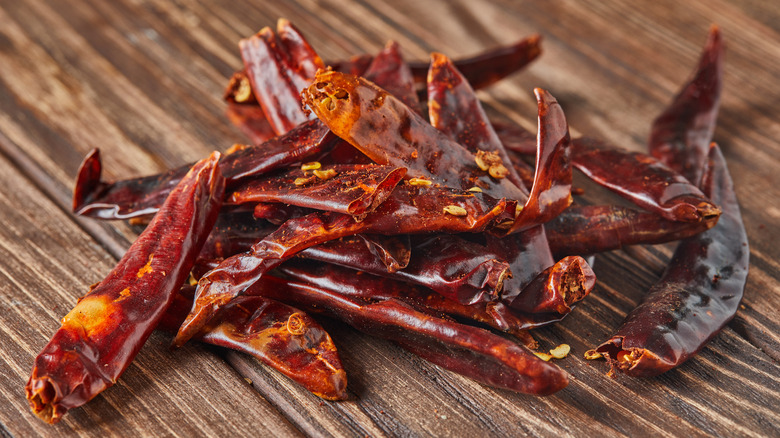12 Ingredients You Should Be Adding To Salsa Verde
There are so many different types of salsa out there — even if they're not all available on your local grocery store's shelf. While pico de gallo and classic restaurant salsa both have their merits, the one type that you should be turning to more often is salsa verde. As its name suggests, this type of salsa goes heavy on everything green. Its base is made of tomatillos and fresh chili peppers, complemented by punchy acidic elements and herbs. It's really a balanced sauce, but it can always be made better.
While the classic salsa verde recipe is rather rudimentary and is often made with the same combination of peppers, herbs, and base ingredients, there are a ton of exciting add-ins that you can use to add more texture and flavor to your recipe. We consulted with two experts — Michelin-honored chef Carlos Gaytán from Tzuco in Chicago, and Erasmo "Ras" Casiano from Colorado's Lucina Eatery and Bar and Xiquita — to learn more about how to make salsa verde, and which additional ingredients will take it to a new level.
Diced onions
Diced onions are popular in varied foods for a reason. They're bright, sharp, and bite the back of your throat when you bite into them. Carlos Gaytán — the first Mexican chef to earn a Michelin star — explains that in a salsa verde, "the onions provide a crispy texture." And although your onions may be pureed into the mixture, you can still decipher those flavor notes, without having to worry about chomping into a whole piece of white onion. You'll also get to see a little color contrast between the specks of onion and the salsa verde.
There are several reasons why white onions should be your go-to for salsa verde compared to other varieties. Most notably, white onions have a rather clean taste — unlike red onions, which easily overstay their welcome. And if you don't like the bright and astringent flavor of chopped raw onions, you can always caramelize them with the tomatillos, jalapeños, and serranos. This will help transform some of those more bitter flavor notes into something subtle and sweet.
Cilantro
Herbs are the secret to any punchy and powerful salsa, and salsa verde is one that packs a heavy dose of this organic element. Cilantro, in particular, is a must-have for Carlos Gaytán's salsa verde, because "the cilantro brings fresh flavors" to the salsa. It's easy to see why — cliantro has slightly citrusy and peppery notes that really contrast the sharpness of the onions and the warmth from other herbs. Plus, it also has a very bright and beautiful color that helps accentuate the green color of the tomatillos.
Granted, this herb isn't everyone's cup of tea. Cilantro tastes like soap to some people, so this ingredient can be an unwelcome addition for them. If you're one of these folks, fear not — there are several different swaps you can make for cilantro in your salsa verde recipe. For one, you can try preparing an Italian salsa verde by substituting the cilantro with parsley. You'll get the same color, without the aftertaste. Plus, this pairs well with many of the other ingredients that our experts recommend for upgrading your next batch of salsa verde.
Avocado
Salsa verde can be a bit thin. But, when you add a creamy ingredient like avocado, you can really transform this spread into something unctuous and spectacular. "Avocado adds a creamy richness that ties everything together," shares Carlos Gaytán.
Avocado is an essential ingredient in our creamy salsa verde recipe. Simply add one whole, ripe avocado (with the pit and the skin removed) to the food processor with the rest of your ingredients. It will give you a slightly thicker salsa that won't make your chips super wet and limp. Plus, the avocado will mesh well with the fresh green herbs and tomatillos, because this ingredient is a great balancer; its mild flavor cushions the sharp blow of white onion and any other strongly flavored ingredients you add, like garlic. It's like your one-stop-shop for a salsa verde with a harmonious and luxurious mouthfeel.
Roasted garlic
Garlic is a great ingredient to add to salsa verde because of its sharpness, and how its stings the tip of your tongue when you bite into it. But if you like a more subtle garlic flavor, you're better off trying roasted garlic in your recipe. "Roasted garlic is a fantastic addition, bringing a deep, smoky sweetness that enhances the tomatillos' tanginess," says Carlos Gaytán.
You can whip up a simple oven-roasted garlic recipe with a few ingredients — including a head of garlic, oil, and seasoning. You'll know when it's time to pull the garlic from the oven when the cloves turn light brown and are a little bit soft. When you blend them with the rest of your salsa verde ingredients, you'll find that the flavor meshes seamlessly, bringing a unique degree of sweetness that you can't really replicate with other salsa verde ingredients.
Mexican crema or sour cream
If you've cooked Tex-Mex or Mexican food before, you may have had a run in or two with crema. Crema is made by blending together heavy cream and buttermilk, which marries together the bright sourness of the cultured milk with the richness of heavy cream. Carlos Gaytán shares that crema gives a distinct richness and silky flavor to salsa verde. Plus, the flavor is rather neutral, so it will lend itself well to the mouthfeel without really altering the flavor. In turn, this will still allow the salsa's herby, peppery, and garlicky notes to shine.
If you can't get your hands on crema, you can always turn to its American counterpart: sour cream. However, it will be hard to replicate crema's richness and tart flavor with this substitute. To combine the sour cream with your other salsa verde staples, simply scoop it in and give it a stir. Gaytán states that this creamy salsa verde "pairs wonderfully with grilled meats, or can be used as a base for enchiladas verdes."
Epazote
Epazote is a Mexican herb that you maybe haven't heard about yet. However, this is one of chef Carlos Gaytán's secrets to upgrading a bowl of salsa verde. "A few leaves of epazote, a traditional Mexican herb, can turn your salsa verde into something truly special, adding a unique, slightly medicinal flavor beloved in many parts of Mexico," he says.
With licorice and anise notes to it, epazote has complexity that makes it nearly impossible to replicate, especially when it's added to things like mole, beans, and, of course, salsa verde. Luckily, it's easier to find than you may think. Epazote grows naturally in the Southwest, and it's sold in the international section of some grocery stores. You'll want to chop the fresh version of this herb and add it with the rest of your ingredients. Since epazote is rather strong, you'll only need to add about a quarter teaspoon to really taste the anise notes with every bite.
Charred scallions
Scallions are a great ingredient to add to a whole host of recipes — especially if you're craving something that brings the allium flavor without the sharpness of a raw onion. But if you want to subdue the flavor of the scallion even more, take the advice of chef Erasmo "Ras" Casiano. "I love using charred scallions in my restaurants, as this simple add not only fortifies the flavors in your sauces, but also works wonders in salad dressings," he says.
He recommends taking a handful of scallions and tossing them with a coating of olive oil before plopping them on the grill and letting them char. You could also use this as a chance to get char on your other salsa verde ingredients, too, like the tomatillos and the onion. From there, transfer the scallions into your blender and combine them with the rest of your ingredients.
Chicken bouillon
Chicken bouillon is a really useful ingredient to have and keep on hand. Erasmo Casiano recommends adding a little bit of it to your next recipe. "The result is a rich, flavorful, yet vibrant salsa verde that will take your dish to the next level," he says.
Casiano explains that chicken bouillon is a pantry staple in Mexican households. Plus, it has all of the salty and umami flavor notes that your salsa is really craving. Some folks use chicken broth in their salsa verde recipe, so it's easy to see how bouillon can be used as a replacement. If you plan on cooking your salsa, you can add in bouillon along with your seasonings.
Chicken bouillon is really concentrated, so you'll want to be cognizant of this when you're making your salsa verde. If you add too many salty elements, like capers in addition to the bouillon, you may risk going into too-salty territory.
Capers
Capers are like perfect little balls of salty magic. You should always keep capers in your pantry because they're bright, zesty, and relatively simple to use. While capers are a common topping for chicken piccata, they can also be the secret weapon for a flavorful salsa verde. The key is to use capers in small quantities, because of how briny their flavor can be. You may only need to add a tablespoon of minced capers for an entire recipe. Like other salty items on this list, there is always the risk of overwhelming the dish with salt, so consider toning down the bouillon and added salt if you're trying to make a cohesive, flavor-balanced recipe.
Capers will certainly add a unique Italian influence to your plate. The saltiness is a great complement to steak, grilled fish, and even polenta, and it can be subdued by some of the acidity from the tomatillos and the brightness from the herbs.
Black garlic
Black garlic is one of those pantry staples that you didn't really know you needed to keep on hand. These cloves are aged so that they develop a soft, squishy consistency, remarkably sweet flavor, and, of course, a black color. When you add this ingredient to your salsa verde, you'll find that the subtle sweetness comes out, along with umami flavor. The black garlic plays well with spicy and salty notes. Moreover, you'll want to stick to pairing it with ingredients that aren't dominating — so consider swapping your cilantro for a milder parsley.
It's important to note that black garlic doesn't really behave like regular garlic. This addition is really thick and sticky, which makes it difficult to cut properly with a knife. When you add black garlic to salsa verde, we recommend pureeing it in the food processor with the rest of your ingredients.
Piloncillo
Something sweet is something good to eat. If you need to add a sprinkle of sweetness to your recipe, consider adding in piloncillo. Often called Mexican brown sugar, this ingredient is not processed like granulated white sugar, so it retains its brown color. The flavor is earthy, and not really as syrupy as conventional brown sugar tends to be. This distinct earthiness makes something that you'll want to consider adding to your salsa verde recipe — with some caveats.
Like other strongly flavored elements, you'll want to avoid being too heavy-handed with the piloncillo, because it could shift the balance of your salsa into something that's far too sweet. You'll also want to grate the piloncillo into the salsa verde to prevent small chunks from forming and distracting from the salsa's otherwise smooth texture.
Dried chilies
Fresh peppers comprise a key element used in salsa verde. Typically, you'll use serrano peppers or jalapeños, but there is a whole world of other chiles to choose from — especially when you consider all of the dried options. One of the best selections for your salsa verde is chile de árbol. Its flavor is quite hot and spicy, compared to the milder jalapeño pepper. These peppers will also give you a grassy, organic flavor that mirrors the salsa's herbs and alliums quite well.
If you don't mind a darker color for your salsa verde, you may also want to try adding in ancho or guajillo peppers to add flavor and a subtle smokiness. Regardless of the pepper type that you select, you'll want to toast them in a pan first to provide a little bit of a smoky edge before soaking them in water and adding them to your recipe.
